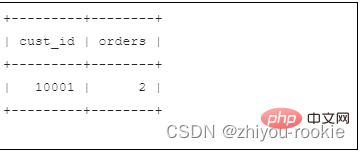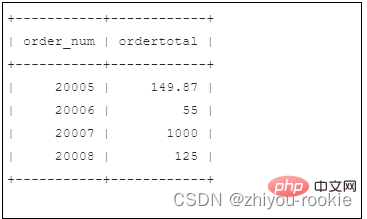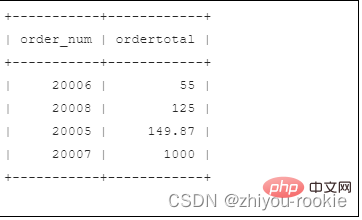Oracle example explains grouped data in detail
This article brings you relevant knowledge about Oracle, which mainly organizes issues related to grouped data. Grouping allows data to be divided into logical groups so that each group can be executed Let’s take a look at aggregate calculations. I hope it will be helpful to everyone.

Recommended tutorial: "Oracle Video Tutorial"
Grouping allows data to be divided into logical groups so that each Groups perform aggregate calculations.
1. Create a group
The group is created using the GROUP BY clause in the SELECT statement.
Example:
SELECT vend_id, count(*) as num_prodsfrom productsgroup by vend_id;

Because of the use of GROUP BY, it will not be necessary to specify each grouping to be evaluated and calculated, which is Completed automatically. The GROUP BY clause instructs Oracle to group the data and perform aggregation on each group (rather than on the entire result set).
Before using GROUP BY, here are some important rules you need to know about using it.
- The GROUP BY clause can contain as many columns as needed. It allows nested grouping, giving more fine-grained control over how data is grouped.
- If you have nested groups in the group by clause, the data will be summarized on the last specified group. In other words, when building a grouping, all columns specified will be evaluated together (so data will not be retrieved for each individual column).
- Each column listed in group by must be a retrieved column or a valid expression (not an aggregate function). If an expression is used in select, the same expression must be specified in group by. Aliases cannot be used.
- Except for aggregate calculation statements, each column in the SELECT statement should appear in the GROUP BY clause.
- If the grouping column contains a column with a NULL value, NULL will be returned as a grouping. If there are multiple rows with NULL values, they will all be grouped together.
- The GROUP BY clause must appear after the WHERE clause and before the ORDER BY clause.
2. Filter grouping
where clause is also usually used for row filtering. However, where does not apply here because where can filter specific rows, not group them. In fact, where cannot be applied to grouping.
Oracle provides another clause for this: HAVING. The only difference between where clause and having clause is: where filters rows, while having filters groups.
**Tips: **having supports all where operators
The rules of where and having have the same syntax, only the key subdivisions are different.
Example:
SELECT cust_id, COUNT(*) AS ordersFROM ordersGROUP BY cust_idHAVING COUNT(*) >= 2;

Note: The difference between having and where
Look at the difference between having and where from another angle: where filtering occurs before data, while having filtering occurs after data grouping. This is an important distinction, rows deleted by the where clause are not included in the grouping. This may change the calculated values based on those used in the having clause, which in turn may affect which groups will be filtered.
Example of using where clause and having clause at the same time:
select vend_id, count(*), as num_prodsfrom productswhere prod_price>=10group by vend_idhaving count(*) > 2;

SELECT vend_id, COUNT(*) AS num_prodsFROM productsGROUP BY vend_idHAVING COUNT(*) >= 2;

3. Grouping and sorting
There is a big difference between group by and order by, even though they are usually used to accomplish the same thing.
The following table describes the difference between order by and group by
| order by | group by |
|---|---|
| #Sort the generated output | Group the rows, but the output may not be in grouping order |
| Any column may be used (even unselected columns) | Only selected columns or expressions may be used, and all selected column expressions will be used |
| Never required | Required if using columns (or expressions) with aggregate functions |
时常,你会发现使用GROUP BY分组的数据的确是以分组顺序输出的。但是并非总是如此,并且实际上SQL规范也并没有如此要求。而且你实际上可能希望它以不同于分组的方式进行排序。你以一种方式对数据进行分组(以获得特定于分组的聚合值),并不意味着你也希望输出以相同的方式进行排序。总是应该还提供一个显式的ORDER BY子句,即使它与GROUP BY子句完全相同。
提示:不要忘记ORDER BY
通常,无论何时使用GROUP BY子句,还应该指定一个ORDER BY子句,这是确保正确地对数据进行排序的唯一方式。永远不要依靠GROUP BY对数据排序。
为了演示同时使用GROUP BY和ORDER BY的情况,让我们看一个示例。下面的SELECT语句类似于之前使用的SELECT语句。它用于检索总价在50以上(含50)的所有订单的订单号和订单总价:
SELECT order_num, SUM(quantity*item_price) AS ordertotalFROM orderitemsGROUP BY order_numHAVING SUM(quantity*item_price) >= 50;

要按订单总价对输出进行排序,只需添加一个ORDER BY子句,如下:
SELECT order_num, SUM(quantity*item_price) AS ordertotalFROM orderitemsGROUP BY order_numHAVING SUM(quantity*item_price) >= 50ORDER BY ordertotal;

4、select子句排序
select子句和它们的顺序
| 子句 | 描述 | 是否必须 |
|---|---|---|
| select | 要返回的列或表达式 | Y |
| from | 要从中检索数据的表 | Y(在Oracle中是必须的;在大多数其他的DBMS中则不是) |
| where | 行级过滤(分组前过滤) | N |
| group by | 分组规范 | 仅当按分组计算聚合值时是必须的 |
| having | 分组级过滤(分组后过滤) | N |
| order by | 输出的排列顺序 | N |
推荐教程:《Oracle视频教程》
The above is the detailed content of Oracle example explains grouped data in detail. For more information, please follow other related articles on the PHP Chinese website!

Hot AI Tools

Undresser.AI Undress
AI-powered app for creating realistic nude photos

AI Clothes Remover
Online AI tool for removing clothes from photos.

Undress AI Tool
Undress images for free

Clothoff.io
AI clothes remover

Video Face Swap
Swap faces in any video effortlessly with our completely free AI face swap tool!

Hot Article

Hot Tools

Notepad++7.3.1
Easy-to-use and free code editor

SublimeText3 Chinese version
Chinese version, very easy to use

Zend Studio 13.0.1
Powerful PHP integrated development environment

Dreamweaver CS6
Visual web development tools

SublimeText3 Mac version
God-level code editing software (SublimeText3)

Hot Topics
 What to do if the oracle can't be opened
Apr 11, 2025 pm 10:06 PM
What to do if the oracle can't be opened
Apr 11, 2025 pm 10:06 PM
Solutions to Oracle cannot be opened include: 1. Start the database service; 2. Start the listener; 3. Check port conflicts; 4. Set environment variables correctly; 5. Make sure the firewall or antivirus software does not block the connection; 6. Check whether the server is closed; 7. Use RMAN to recover corrupt files; 8. Check whether the TNS service name is correct; 9. Check network connection; 10. Reinstall Oracle software.
 How to solve the problem of closing oracle cursor
Apr 11, 2025 pm 10:18 PM
How to solve the problem of closing oracle cursor
Apr 11, 2025 pm 10:18 PM
The method to solve the Oracle cursor closure problem includes: explicitly closing the cursor using the CLOSE statement. Declare the cursor in the FOR UPDATE clause so that it automatically closes after the scope is ended. Declare the cursor in the USING clause so that it automatically closes when the associated PL/SQL variable is closed. Use exception handling to ensure that the cursor is closed in any exception situation. Use the connection pool to automatically close the cursor. Disable automatic submission and delay cursor closing.
 How to create cursors in oracle loop
Apr 12, 2025 am 06:18 AM
How to create cursors in oracle loop
Apr 12, 2025 am 06:18 AM
In Oracle, the FOR LOOP loop can create cursors dynamically. The steps are: 1. Define the cursor type; 2. Create the loop; 3. Create the cursor dynamically; 4. Execute the cursor; 5. Close the cursor. Example: A cursor can be created cycle-by-circuit to display the names and salaries of the top 10 employees.
 How to stop oracle database
Apr 12, 2025 am 06:12 AM
How to stop oracle database
Apr 12, 2025 am 06:12 AM
To stop an Oracle database, perform the following steps: 1. Connect to the database; 2. Shutdown immediately; 3. Shutdown abort completely.
 How to paginate oracle database
Apr 11, 2025 pm 08:42 PM
How to paginate oracle database
Apr 11, 2025 pm 08:42 PM
Oracle database paging uses ROWNUM pseudo-columns or FETCH statements to implement: ROWNUM pseudo-columns are used to filter results by row numbers and are suitable for complex queries. The FETCH statement is used to get the specified number of first rows and is suitable for simple queries.
 What steps are required to configure CentOS in HDFS
Apr 14, 2025 pm 06:42 PM
What steps are required to configure CentOS in HDFS
Apr 14, 2025 pm 06:42 PM
Building a Hadoop Distributed File System (HDFS) on a CentOS system requires multiple steps. This article provides a brief configuration guide. 1. Prepare to install JDK in the early stage: Install JavaDevelopmentKit (JDK) on all nodes, and the version must be compatible with Hadoop. The installation package can be downloaded from the Oracle official website. Environment variable configuration: Edit /etc/profile file, set Java and Hadoop environment variables, so that the system can find the installation path of JDK and Hadoop. 2. Security configuration: SSH password-free login to generate SSH key: Use the ssh-keygen command on each node
 How to create oracle dynamic sql
Apr 12, 2025 am 06:06 AM
How to create oracle dynamic sql
Apr 12, 2025 am 06:06 AM
SQL statements can be created and executed based on runtime input by using Oracle's dynamic SQL. The steps include: preparing an empty string variable to store dynamically generated SQL statements. Use the EXECUTE IMMEDIATE or PREPARE statement to compile and execute dynamic SQL statements. Use bind variable to pass user input or other dynamic values to dynamic SQL. Use EXECUTE IMMEDIATE or EXECUTE to execute dynamic SQL statements.
 What to do if the oracle log is full
Apr 12, 2025 am 06:09 AM
What to do if the oracle log is full
Apr 12, 2025 am 06:09 AM
When Oracle log files are full, the following solutions can be adopted: 1) Clean old log files; 2) Increase the log file size; 3) Increase the log file group; 4) Set up automatic log management; 5) Reinitialize the database. Before implementing any solution, it is recommended to back up the database to prevent data loss.






